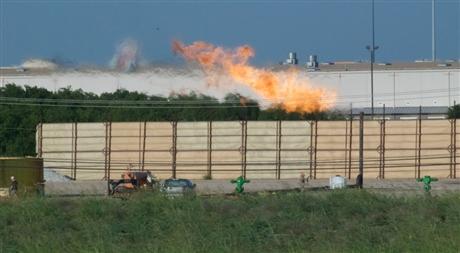Someone Tell the Task Force: Cancer Risks Two-Thirds Higher Within 1/2 mile of Gas Wells
 People living within a half-mile of oil- and gas-well fracking operations were exposed to air pollutants five times above a federal hazard standard, according to a new study by the University of Colorado School of Public Health. As a result, cancer risks were estimated to increase by at least 66% for those residents. Scientists found toxic and smog-forming Volatile Organic Compounds such as trimethylbenzenes, aliphatic hydrocarbons, and xylenes at elevated levels as far as 2640 feet away from fracking sites over the last three years in Garfield County, Colorado. Those chemicals can have non-cancerous neurological or respiratory effects that include eye irritation, headaches, sore throat and difficulty breathing. “Non-cancer health impacts from air emissions due to natural-gas development is greater for residents living closer to wells,” the report’s press release says. “We also calculated higher cancer risks for residents living nearer to the wells.” The report is believed to be the longest-term study yet of gas field air pollution risks but did not look at the full range of chemicals released from fracking operations, which also includes diesel fumes and methane, or impacts beyond a half-mile. “Our data show that it is important to include air pollution in the national dialogue on natural-gas development that has focused largely on water,” said Lisa McKenzie, the study’s lead author. Most DFW cities have setbacks, or buffer zones surrounding gas wells of only 300 to 1500 feet, with most providing “variances” that allow drilling even closer to homes, schools and businesses. This report should cause all those previous distance requirements to be re-examined and is acutely embarrassing for most of the members of The Dallas Gas Drilling Task Force, who voted to roll back a recommended 1000-foot buffer zone to 500 feet only a couple of weeks ago. That decision looks even more seriously wrong-headed in light of this data. Downwinders at Risk board and Dallas Task Force member Cherelle Blazer kept insisting during the proceedings that there was plenty of evidence to show public health harms as far as a mile away from a fracking site. Here’s one more piece. Over at Bluedaze, Sharon cites a local air monitoring study in the Bartonville-Argyle area just south of Denton where baseline testing when drilling was just getting started showed 7 detects of the 84 chemicals typically tested for by TCEQ. After drilling took off there, testing showed 65 detects of the 84 chemicals typically tested for by TCEQ. This was on the lot where the high school band practices, about a half-mile from gas wells. Gas wells are toxic facilities that should not be allowed to operate in residential areas or close to people under any circumstances. Don’t want to see the same threat to your family’s health in Dallas? Come on out to next Tuesday’s citywide organizing meeting on Gas Drilling in Dallas, 7 pm, at 2900 Live Oak in the Center for Community Cooperation. Download the flyer and resolution on this page.
People living within a half-mile of oil- and gas-well fracking operations were exposed to air pollutants five times above a federal hazard standard, according to a new study by the University of Colorado School of Public Health. As a result, cancer risks were estimated to increase by at least 66% for those residents. Scientists found toxic and smog-forming Volatile Organic Compounds such as trimethylbenzenes, aliphatic hydrocarbons, and xylenes at elevated levels as far as 2640 feet away from fracking sites over the last three years in Garfield County, Colorado. Those chemicals can have non-cancerous neurological or respiratory effects that include eye irritation, headaches, sore throat and difficulty breathing. “Non-cancer health impacts from air emissions due to natural-gas development is greater for residents living closer to wells,” the report’s press release says. “We also calculated higher cancer risks for residents living nearer to the wells.” The report is believed to be the longest-term study yet of gas field air pollution risks but did not look at the full range of chemicals released from fracking operations, which also includes diesel fumes and methane, or impacts beyond a half-mile. “Our data show that it is important to include air pollution in the national dialogue on natural-gas development that has focused largely on water,” said Lisa McKenzie, the study’s lead author. Most DFW cities have setbacks, or buffer zones surrounding gas wells of only 300 to 1500 feet, with most providing “variances” that allow drilling even closer to homes, schools and businesses. This report should cause all those previous distance requirements to be re-examined and is acutely embarrassing for most of the members of The Dallas Gas Drilling Task Force, who voted to roll back a recommended 1000-foot buffer zone to 500 feet only a couple of weeks ago. That decision looks even more seriously wrong-headed in light of this data. Downwinders at Risk board and Dallas Task Force member Cherelle Blazer kept insisting during the proceedings that there was plenty of evidence to show public health harms as far as a mile away from a fracking site. Here’s one more piece. Over at Bluedaze, Sharon cites a local air monitoring study in the Bartonville-Argyle area just south of Denton where baseline testing when drilling was just getting started showed 7 detects of the 84 chemicals typically tested for by TCEQ. After drilling took off there, testing showed 65 detects of the 84 chemicals typically tested for by TCEQ. This was on the lot where the high school band practices, about a half-mile from gas wells. Gas wells are toxic facilities that should not be allowed to operate in residential areas or close to people under any circumstances. Don’t want to see the same threat to your family’s health in Dallas? Come on out to next Tuesday’s citywide organizing meeting on Gas Drilling in Dallas, 7 pm, at 2900 Live Oak in the Center for Community Cooperation. Download the flyer and resolution on this page.
